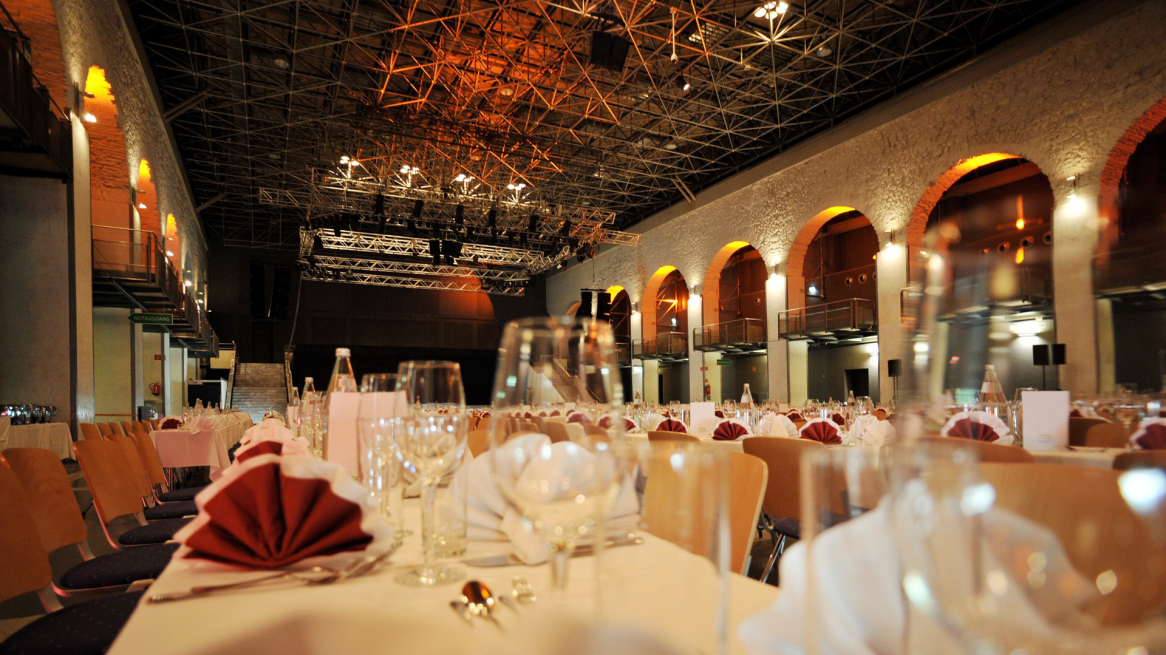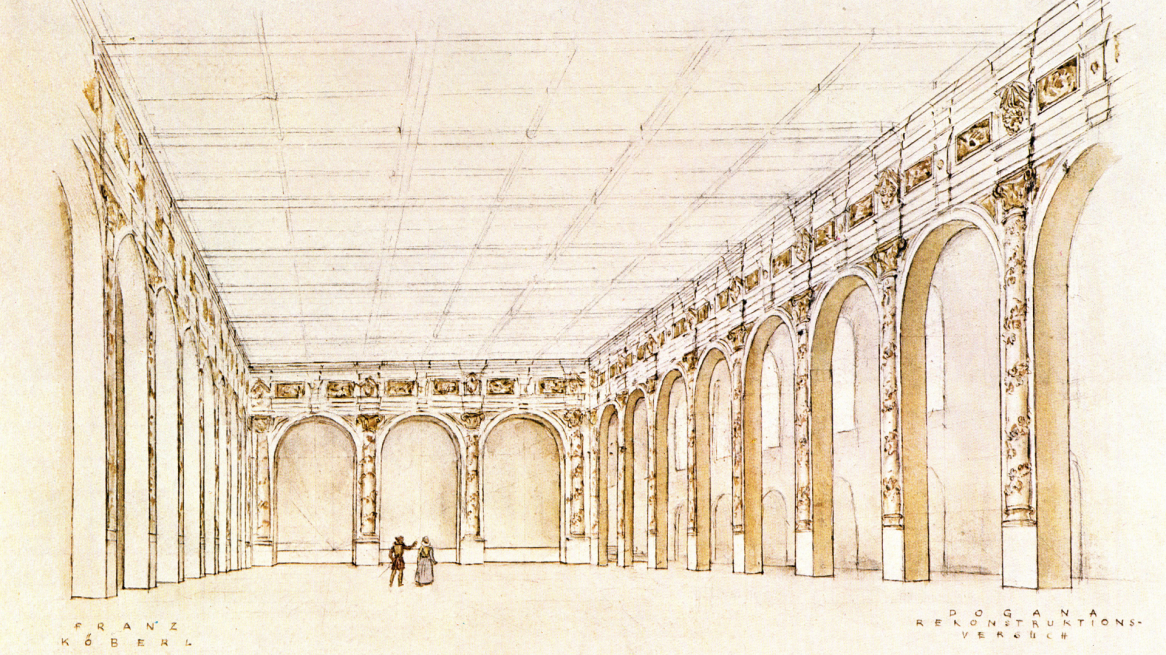
The largest hall of the Congress Innsbruck congress Innsbruck bears the name "Dogana." For almost 50 years, events of all kinds have been held there, but the history of this building goes back much further. Probably no other building has been more versatile than the Dogana. What began as a ballroom in the late 16th century led to a grand opera house, a court riding school, a customs office, a ruin during World War II, and finally an event location.
Events without end
Many Tyroleans know the Dogana as the heart of the Congress Innsbruck and have experienced concerts, shows, congresses, fairs, balls or glittering New Year's Eve parties there. Among my personal fondest Dogana memories are concerts by AnnenMayKantereit, Sportfreunde Stiller or Reinhard Mey, a magic show by Thommy Ten and Amélie van Tass, the European Outdoor Film Tour (E. O. F. T.), the Tirolissimo awards gala and some exuberant ball nights. Whole generations of students who had Innsbruck a high school graduated, celebrated - as I did - their Matura balls at the same place.
On all these occasions, one thinks little of the long history of the event hall, yet part of the historic walls are still visible today. And these walls would certainly have a lot to tell ..
Ballroom
The position of the Dogana is in the immediate vicinity of the historic court of Innsbruck, to which Imperial Palace, Court Church, Court Garden and Rennplatz (today Rennweg) belonged to it. Therefore, if the princes wanted to structurally expand this court, it was only logical to do so right there.
Archduke Ferdinand II (1529-1595) had built Ambras Castle created a Renaissance jewel above Innsbruck. In addition, he had a total of three ballrooms built in Innsbruck: one at Ambras Castle and two at the Hofburg (until 1582), one of which was located on the square of the Dogana.
Various ball sports were played in the ballrooms, mainly the balloon game, but also a kind of tennis. So they were used for entertainment and physical exercise.
After Ferdinand II, the balloon game quickly lost popularity and soon the large ball game house was used for various events.
Comedy House
Attempt to reconstruct the interior decoration of the Dogana, watercolor pen and ink drawing by Franz Köberl (scan)
Archduke Leopold V(1586-1632) and his wife Claudia de' Medici (1604-1648) brought much art, musical enthusiasm and Italian influence to Innsbruck. Under them, the large ballroom, 100 meters long and 30 meters wide, was enlarged and rebuilt into a comedy house. After changing builders, Christoph Gumpp finally completed the building in 1630. It was probably the first free-standing hall theater in the north of the Alps.
Baroque theater, with its elaborate technology, music and many participants, demanded a large stage, and this was created in the Komödienhaus. Operas, plays, but also opulent productions such as water battles or horse ballets could now be performed.
From the outside, the Comedy House was unadorned, but inside it was richly decorated. Arcades ran along its entire length, with balconies behind them as spectator galleries. These arcades are still visible in the Dogana today!
Stage set from the opera L'Argia on the occasion of the visit of Queen Christine of Sweden to Innsbruck; copperplate engraving, 1655 (scan)
An opera for Queen Christine of Sweden
Archduke Ferdinand Karl (1628-1662), the son of Leopold V and Claudia de' Medici, had another court opera house built in 1653. It stood on the site where today the Tyrolean State Theater is located today. Thus, at the very time when all of Europe was suffering from the horrors and consequences of the Thirty Years' War, two theater buildings were erected in Innsbruck. (Quite decadent, actually.)
The music, theater and opera scene flourished in Innsbruck at this time, and renowned composers and musicians made sure of that.
Probably the most important opera performance took place in honor of the Swedish Queen Christine in 1655. Queen Christine traveled to Rome to convert to the Catholic faith. In the Innsbruck Court Church she made the Catholic profession of faith for the first time. The five-hour opera L'Argia by Marc Antonio Cesti was premiered on this occasion. The performance probably already took place in the new opera house.
Riding school
The southern part of the Komödienhaus was soon also used as the court's riding school. The building was adapted accordingly and equipped with an upper gallery, among other things. However, its function as a court theater was retained.
Structurally, this court riding school in Innsbruck served as a model for the famous Spanish Riding School in Vienna.
University Library
From 1745, the former court riding school served as the public library of the University. The first main university building in Herrengasse was thus in the immediate vicinity.
When the university and its library were moved to the abandoned Jesuit College in 1776-1777, the former university building in Herrengasse and the library rooms in the Komödienhaus were put to subsequent use by the government chancellery or governor's office.
A toll and customs office called Dogana
A more extensive reconstruction followed in the years 1808-1810 under Bavarian occupation. The building was now given the function of a toll hall and the name "Dogana." With the end of Bavarian rule in 1815, the toll hall was also closed. After that, the empty hall was occasionally used for large events.
With the General Assembly of the Catholic Associations of Austria in September 1867 in the Dogana, Innsbruck's time as a Congress city inaugurated. And this more than a hundred years before the opening of today's Congress House.
Bomb ruin
The slow and gradual decay of the Dogana came with the beginning of the 20th century.
The brutality of the Second World War finally hit the building on Rennweg with its long history: on December 16, 1944, the building was largely destroyed by bomb hits. Only the walls with the round arches, which date back to the Komödienhaus, remained as remnants.
In addition to the Dogana and many other houses in Innsbruck, the Cathedral of St. Jacob was severely damaged by bombs.
In the post-war period, the Dogana was one of the most famous ruins in the capital of Tyrol. The arcades remained standing for 25 years, while the former auditorium of the Komödienhaus was used as a parking lot.
A new congress center for Innsbruck
The City of Innsbruck received the remains of the building in 1954 and subsequently began planning a congress center on the site. It was decided to integrate the historic wall remains into the new building.
The Congress Center was designed and planned by the architectural partnership of Heinz Marschalek, Norbert Gantar, Hubert Prachensky, Georg Ladstätter, Ernst Heiss and Peter Thurner. Construction lasted from 1970 until the opening of the event center in 1973. The numerous works of art in the building are by Markus Prachensky, Rudi Wach and Fritz Wotruba, among others.
In 1995, the house was significantly enlarged and remodeled. The addition of the Orangery, the redesign of the main entrance, and the modernization of various halls and foyer areas followed in the early 2000s.
Congress Innsbruck
Under the name "Congress Innsbruck" the congress center now belongs to the Congress Fair Innsbruck. At the three locations Congress Innsbruck, Messe Innsbruck and congresspark igls, events of all kinds take place - from small private celebrations and international congresses to large trade and public fairs.
Congress Innsbruck has received many awards, such as the Apex Award as "Congress Centre of the Year 2001."
All's well that ends well
The fact that the Dogana, after all the different stages in its history, once again became part of an event center and has remained so to this day seems impressive. I even find it touching.
In the (relatively) short time I've known the Dogana, I'm always surprised at how versatile and adaptable this hall is. With the help of decoration, equipment and technology, the ambience is right for any occasion. - But with this history, that's hardly surprising. It remains to be seen what will happen in the future..
I would like to express my sincere thanks for the kind help and support of the staff of the Congress Messe Innsbruck. Thank you.
Links
Congress Messe Innsbruck: Rennweg 3, 6020 Innsbruck, Tel. +43 512 5936-0, info@cmi.at, www.cmi.at
Blog article "Congress Messe Innsbruck by Susanne Gurschler
Sources
The Innsbruck Congress House Tyrolean Events Center, edited and published by
Kongreßhaus-Baugesellschaft m. b. H., Innsbruck 1974
To the congress house, part 1/2, Innsbruck remembers, City Museum/City Archive Innsbruck
The Dogana - The most famous ruin of Innsbruck, Innsbruck Remembers,
Stadtmuseum/Stadtarchiv Innsbruck
Congress House Innsbruck, Wikipedia
Picture credits
Cover picture: Gala in the Dogana, Photo: © Congress Messe Innsbruck
Scans: all from the book "Das Innsbrucker Kongreßhaus Tiroler Veranstaltungszentrum,"
edited and published by Kongreßhaus-Baugesellschaft m. b. H., Innsbruck 1974
Rate this article
Show me the location on the map
A Tyrolean girl, graphic designer, blogger and tour guide with a variety of interests and a weakness for nice people, culture, starry night skies, one more beer and the mountains.
Similar articles
The museum in Innsbruck's Arsenal "Museum im Zeughaus" was reopened on April 6,…
The Ferdinandeum regional museum is open until June 30, 2024, with exhibitions and events. Then a…
A purely Tyrolean film project aims to shed new light on the novel story of probably…
With the Alpine Jitterbugs, Innsbruck has a club that is passionately dedicated to swing dancing. The Alpine…













